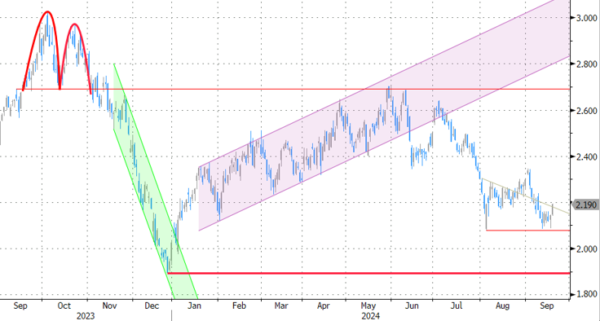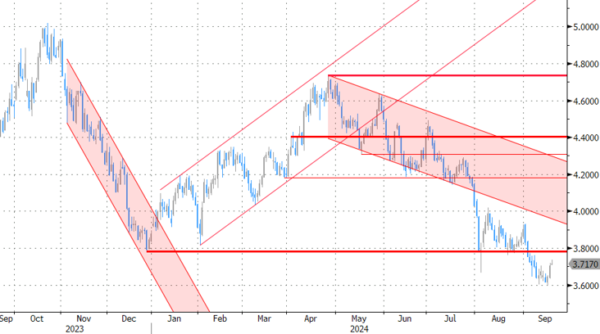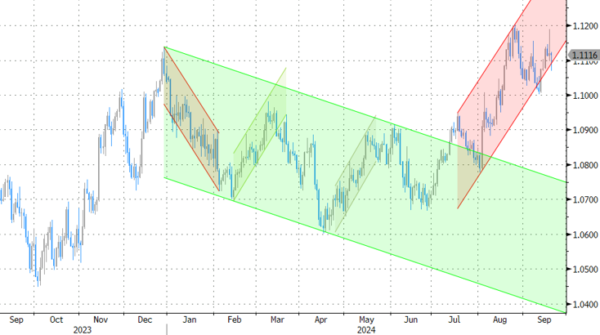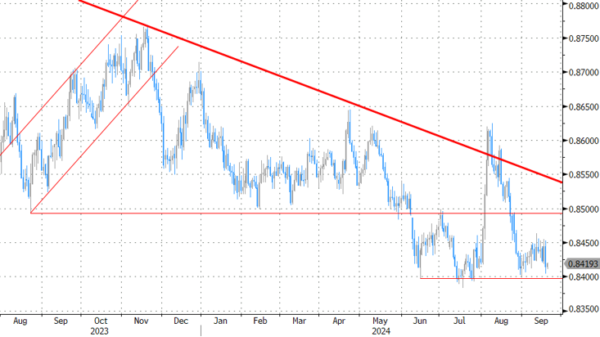Markets
We’re finally here. The US Fed took a first, bold step in paring back monetary restrictiveness after keeping rates steady for more than a year. The decision to cut by 50 bps (to 4.75-5%) in the new pursuit to neutral comes amid a shift in the balance of risks in its employment and inflation goals. The statement is now saying that both are roughly in balance (vs. being in the process of). Money markets were divided on the size of yesterday’s cut. For Powell the near-unanimous (Fed governor Bowman dissented) move was a way to demonstrate the central bank’s resolve to protect the labour market and economy from further undue weakness. The dot plot showed another 50 bps of cuts this year, followed by 100 bps more in 2025 and 50 bps in 2026 with a flat rate in the first print for 2027 (2.75-3%). Just as Powell did in the presser we’d downplay the relevance of these individual guesstimates, especially in an easing cycle – which is never as gradual as the dot plot suggests. The chair referred to the dot plot as a baseline scenario from which they can deviate. All it takes is one downside surprise in one of the two payrolls reports due between today and the November 7 meeting and the Fed is ready to jump in. Adding to the argument is their very conservative 4.4% peak forecasted for the unemployment rate which risks being caught up by reality soon. We do retain another upward appreciation of the neutral rate from 2.8% to 2.9%. Powell was explicit in saying that this equilibrium rate was “probably significantly higher” than it was before the pandemic. For most of the presser, Powell sought to spiraling market expectations by not committing to anything, just as anyone would have expected him to do. That sufficed from a daily point of view. US yields reversed kneejerk losses and ended up between 1.4 and 6.1 bps higher in a curve steepener. A similar U-turn kept the US dollar at bay. First resistance in EUR/USD (1.1119) at 1.1202 was never really under threat. We’re curious to the market’s second reading of the Fed today though. In any case we remain cautious on US yields and the dollar and look out for the first major US data releases early October.
The Bank of England is in the spotlights today. We don’t expect the central bank to follow the ECB and Fed with a cut. The one in August was a close call for some and we think the recent string of data, including yesterday’s rising (services) CPI, won’t have those same policymakers voting for another move down again just yet. The November meeting, featuring updated forecast, on the other hand is a live one. This is exactly what is priced in. Sterling’s reaction to the status quo at 5% should therefore stay limited.
News & Views
The Brazilian central bank (BCB) raised its policy rate yesterday by 25 bps, from 10.50% to 10.75%, bucking the global trend and showing what a soft landing might entail. The BCB was frontrunner in the early stages of the pandemic recovery to spot the inflation danger and start an aggressive tightening cycle, bringing the policy rate from 2% to 13.75%. As disinflation started, they gradually lowered the Selic target rate to 10.50%. It remained there since May until yesterday. Domestic indicators on the economic activity and the labour market have been stronger than expected, suggesting a positive output gap. Headline and core inflation measures moved back above the central bank’s inflation target. Inflation expectations remain deanchored and are one of the upside inflation risks together with services inflation. The BCB commits to further rate adjustments, but will let inflation decide on the pace and on the total magnitude. Lack of synchrony in monetary policy cycles across counties, and especially the US, continue to require caution. USD/BRL yesterday tested 5.40, the neckline of a technical head-and-shoulders pattern.
The August Australian labour market report was close to consensus. Employment increased by 47.5k (vs 26k expected) but following a downward revision to July figures (48.9k from 58.2k). Details showed a small decrease in the number of full-time employed people (-3.1k) with half-time jobs accountable for the August increase (+50.6k). The unemployment and labour force participation rates stabilized respectively at 4.2% and 67.1%. Head of the Australian Bureau of Statistics, Kate Lamb, said that the employment and participation measures remain historically high, while unemployment and underemployment measures are still low. This suggests the labour market remains relatively tight. The Aussie dollar profits this morning with AUD/USD testing the 0.68 resistance area as data strengthen the RBA’s current higher-for-longer approach.
Graphs
GE 10y yield
The ECB cut policy rates by 25 bps in June and in September. Stubborn inflation (core, services) make follow-up moves less evident. We expect the central bank to stick with the quarterly reduction pace. Disappointing US and unconvincing EMU activity data dragged the long end of the curve down. The move accelerated during the early August market meltdown.
The Fed kicked off its easing cycle with a 50 bps move. It is headed towards a neutral stance now that inflation and employment risks are in balance. Conservative SEP unemployment forecasts risk being caught up by reality and with it the dot plot (50 bps more cuts in 2024). We hold our call for two more 50 bps cuts this year. Pressure on the front of the curve and weakening eco data keeps the long end in the defensive for now as well.
EUR/USD
EUR/USD moved above the 1.09 resistance area as the dollar lost interest rate support at stealth pace. US recession risks and bets on fast and large rate cuts trumped traditional safe haven flows into USD. EUR/USD 1.1276 (2023 top) serves as next technical references.
EUR/GBP
The BoE delivered a hawkish cut in August. Policy restrictiveness will be further unwound gradually on a pace determined by a broad range of data. The strategy similar to the ECB’s balances out EUR/GBP in a monetary perspective. Recent better UK activity data and a cautious assessment of BoE’s Bailey at Jackson Hole are pushing EUR/GBP lower in the 0.84/0.086 range.

















